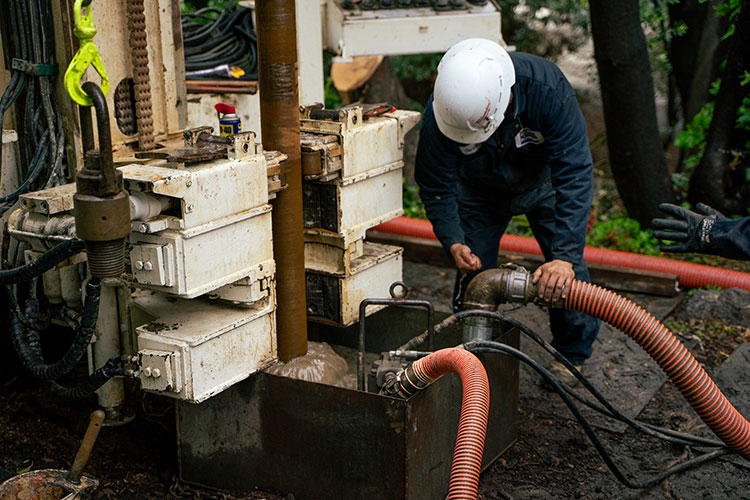UC Berkeley Drills 400-Foot Borehole to Explore Geothermal Heating on Campus
Early this past Monday morning, a small team of University of California, Berkeley, engineers gathered around a two-story-tall drilling rig parked at an out-of-the-way spot on the north side of campus. As the overnight rain turned to drizzle, the team watched as a drilling crew used a massive 8-inch-wide drill bit to start punching a new borehole in the soil.
By the end of the week, this borehole will extend 400 feet below ground, becoming the deepest borehole on campus and providing engineers with the first opportunity to study the properties of the bedrock that sits below UC Berkeley. They will use the information that they gather from the borehole to help determine whether a geothermal heat pump system — which uses the thermal properties of subsurface rock to help heat and cool buildings more efficiently — could be integrated into UC Berkeley’s long-term plans for decarbonizing its energy system.
“Nobody has ever drilled this deep beneath the campus,” said Kenichi Soga, the Chancellor’s Professor and Donald H. McLaughlin Chair in Mineral Engineering at UC Berkeley. “Most of the boreholes that we have on campus are used for designing new buildings and typically only go down to 60 or 80 feet. Now, we’re going to 400 feet. It’s going to let us see what is happening at that depth and better understand the possibility of using geothermal heat pumps on campus.”

Unlike deep geothermal energy systems, which use boreholes as deep as 10,000 feet or more to harvest heat from Earth’s core, geothermal heat pump systems use the thermal properties of the near underground. In these systems, the heating and cooling needs for a community are provided by a network of water pipes, which run through shallow boreholes that extend approximately 400 to 500 feet below the surface. Ideally, these systems take heat that is generated by cooling buildings during the summer and store it underground, where it can be used to heat buildings during the winter.
As part of the Clean Energy Campus Initiative, UC Berkeley plans to decommission its 40-year-old cogeneration plant and replace its current steam heating system with a new system that uses water pipes to heat and cool buildings on campus. While the cogeneration plant burns natural gas to produce electricity and steam heat for the campus, the new system will use electricity for both power and thermal needs. By using clean energy sources, such as wind and solar, to produce this electricity, the campus’s future power, heating and cooling needs would be entirely carbon-free.
The borehole will provide the research team with the first detailed measurements of the geological conditions hundreds of feet below the campus, a necessary first step in determining whether geothermal technologies can be used to make this heating and cooling system even more energy efficient. The primary support for this initial borehole was provided by The Green Initiative Fund, a grant program funded by UC Berkeley student fees and administered by a student-majority committee.
“We need to replace this cogeneration plant because its useful life is almost over, and we want to pivot and build something for the future,” said Kira Stoll, chief sustainability and carbon solutions officer at UC Berkeley. “Our goal is to have the campus transition to using 100% clean energy to heat and cool our buildings by 2028. I’m looking forward to finding whether we do have geothermal potential on the campus and whether we can integrate that into our plans to make a very efficient clean energy system.”
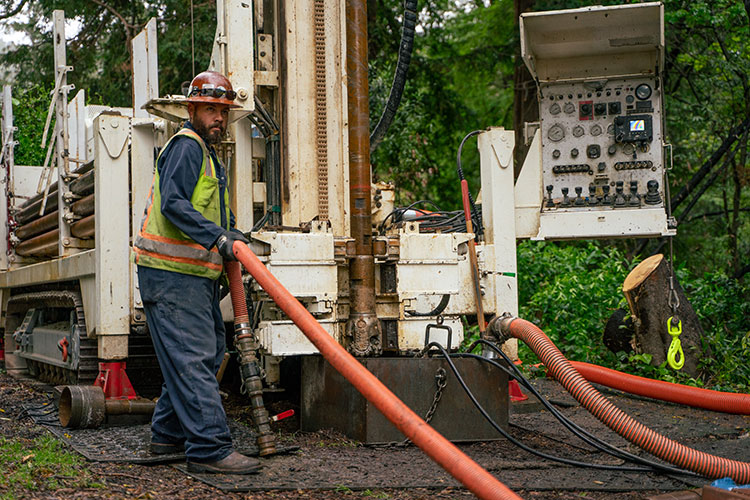
A storage tank for heat
Many of the devices that we use to keep things cool rely on heat pumps, which work by redistributing heat energy from one location to another. For example, air conditioning systems work by transferring heat energy from the inside of a building to the outside of a building.
Because rock and soil have a much larger heat capacity than air — they can absorb and store more heat energy without letting it diffuse away — the ground underneath our feet can essentially act as a storage tank for heat. Geothermal heat pumps, also known as ground source heat pumps, are designed to pump excess heat underground into boreholes, where it can be stored.
“If you pump heat outside into the air, it will quickly dissipate, whereas if you heat or cool down a large amount of rock, then it will stay hot or cold for a much longer period of time, and you can potentially get the hot or cold back,” said Peter Nico, soil and environmental biogeochemist and acting division director for the Energy Geosciences Division at Lawrence Berkeley National Laboratory (Berkeley Lab).
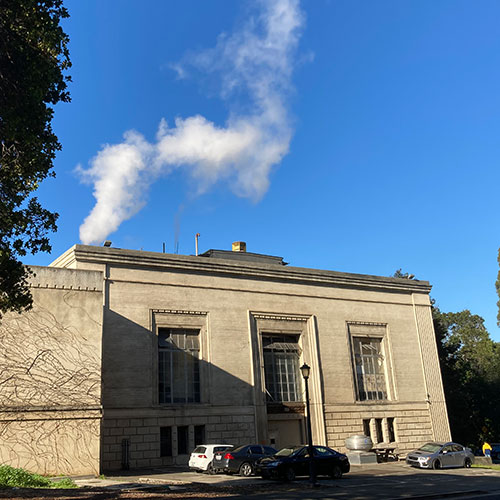
Typically, these ground source heat pumps are used for residential homes; each home may have one or two boreholes to reduce its heating and cooling costs. However, geothermal heat pumps are less commonly implemented for larger community or district heating systems, such as the system used on the UC Berkeley campus.
For three years, Soga, Nico and other researchers from UC Berkeley and Berkeley Lab have been investigating how communities can optimize ground source heat pumps and other geothermal technologies to provide energy to communities more sustainably through a project sponsored by the U.S. Department of Energy’s Geothermal Technologies Office.
The exploration of a community geothermal system on the UC Berkeley campus will draw from the expertise gained by the researchers about how to integrate the most efficient above-ground district heating systems with new geothermal technologies. But first, the team needs a detailed understanding of the geological conditions hundreds of feet below the surface of campus.
“Designing geothermal systems correctly is very important for reducing costs and ensuring their overall effectiveness,” Nico said. “The better you understand what’s happening underground, the better you can design and build your system.”
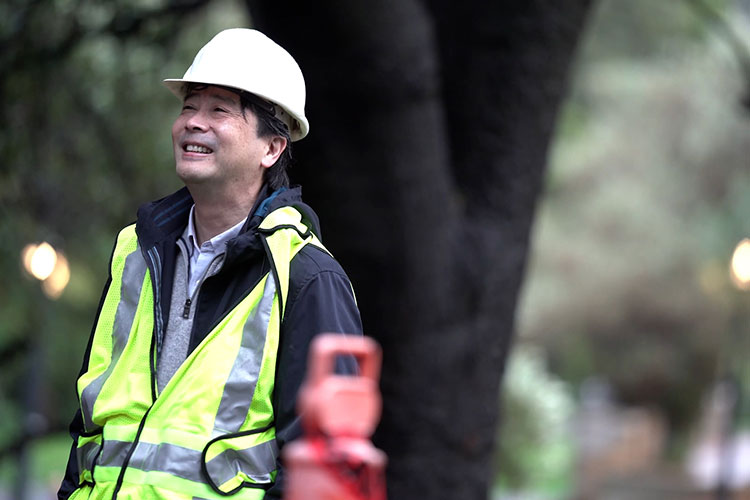
A view 400 feet below the campus
After the drilling is complete and the borehole has been reinforced, the research team will install a variety of instruments to monitor the conditions underground. These instruments, which were donated by Berkeley Lab or funded by a grant from the National Science Foundation, include a geothermal heat loop, which will pump water deep into the borehole and back out again, allowing the team to monitor how the trip underground impacts the water temperature. In addition, fiber optic cables will measure the temperature and vibrations at different strata of the soil, and pressure gauges will measure the groundwater pressure at different depths.
Taka’aki Taira, a research seismologist at the Berkeley Seismology Lab, will also be installing a device called a geophone, which will measure seismic activity. Data from the geophone, along with the Seismology Lab’s network of seismic sensors, will be used to explore micro-earthquake activity near the campus.
“If you put the sensor deep in the ground, you can minimize the noise caused by cars or humans,” Taira said. “It makes it easier to see small vibrations, such as those caused by the Hayward Fault.”
The data gathered from the borehole will allow the research team to build a “digital twin” of the campus heating system, a detailed model of both the heating needs of the buildings above ground and the rock and groundwater conditions below ground. With this model, the researchers will be able to run simulations to determine the most efficient design for the new system.
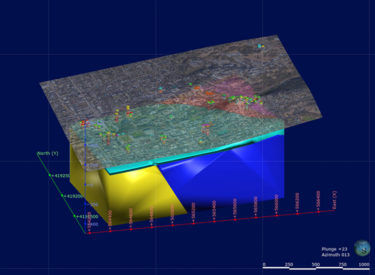
Drilling boreholes is one of the biggest costs associated with geothermal heat storage, and so one of the most important aspects of the design will be to find out how many boreholes are needed, how deep they should be and where they should be located. While a smaller building or residence may only require one or two boreholes to manage its heating and cooling system, large, energy-hungry buildings, like those on campus, could require hundreds of boreholes. Geological factors, such as the presence of flowing groundwater, can also impact how many boreholes are needed for a specific system, and where they are placed.
“Up until now, many district heating systems have been centralized, meaning that they produce heat or cold in one location and then distribute it to the buildings where it is needed. In the next generation of district heating systems, each building manages its own heating and cooling, while also sharing with each other,” Soga said. “Our research is looking at whether these systems are more efficient using a centralized field of ground source heat pumps, where you have a lot of boreholes placed in one location, or whether it better to have boreholes placed in discrete locations across campus.”
In addition to contributing to a new clean energy system on campus, the project is also helping to train the next generation of scientists and engineers on how to design and implement these systems in the future. Soga said he hopes the undergraduate and graduate students working on the project start to see how these different technologies, including geothermal heat pumps and renewable energy, can work together to help decarbonize our energy needs.
Kecheng Chen, a graduate student in civil systems at UC Berkeley, is helping to build the digital twin models that will help inform the design of a system.
“Our goal is to understand how geothermal energy can be used for UC Berkeley campus buildings’ heating and cooling, but this idea can also be applied to other districts or cities,” Chen said. “Our campus’s current heating and cooling system is not that efficient, and we want to use more renewable energies in the future to achieve our carbon zero carbon goals. But the work is also a case study to see if it is possible to apply these technologies on a wider scale.”
